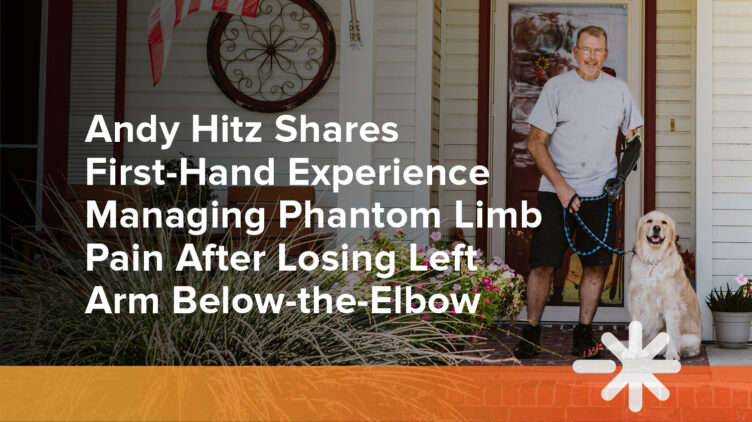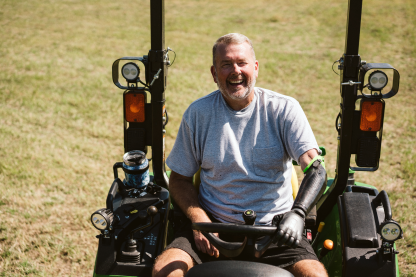Andy Hitz Shares First-Hand Experience Managing Phantom Limb Pain After Losing Left Arm Below-the-Elbow

After 40 years as a full-time airline mechanic, Andy retired to enjoy life working on his small farm at home. In 2014, the unthinkable happened when he suffered a traumatic accident on his utility task vehicle (UTV) that left him a below-the-elbow amputee. Post-surgery, he experienced phantom limb pain, which is fairly common in amputees. Andy walks us through his experience and the techniques he used to help address the pain.
When did you start to notice your phantom limb pain?
I had pain post-amputation surgery as a below-the-elbow amputee as most people would expect. But as time went on, I felt like my arm, hand, and fingers I lost were still there, and my pain continued past my healing time. I used pain medications and therapy, but as the pain continued on, it began to affect my mental health. After time, I realized pain medications like hydrocodone were not a good way to live and looked for other options to help control the pain.
In the beginning, what did you do to try to address the pain?
It was hard. I had two arms and in a moment, one arm was gone and I was left with this pain. Since the beginning, I worked to help my limb heal. I started with a shrinker to promote proper healing and minimize limb pain. Once my limb healed, I tried to desensitize my limb with rubbing, pressure, and hot/cold bean bags. The tools and resources available through Hanger Clinic were such a helpful place to start.
When do you feel the pain the most?
After my amputation, I would feel the pain throughout the day. As time progressed, I would not feel pain as much during the day when I was busy on my small farm and running around. But when I actually sat down and relaxed in the evening, when I wasn’t focused on the activities I was trying to accomplish during the day, I would feel the pain flair up.
As the phantom limb pain continued, what did you do to continue to address it?
It was very difficult. From the time of the accident, I had 17 surgeries over five years. I was in pain throughout this experience, despite going to all my therapy sessions. I continued to address the pain through surgeries and with treatments like compression, desensitization, targeted muscle reinnervation (TMR), a transcutaneous electrical nerve stimulation (TENS) unit, rubbing therapy, hot/cold therapy, apps to train your mind, and mirror box therapy. I even used a bag of rice to help with desensitization.
One of the most impactful options for me was the TMR surgery. It reassigned the nerve that once controlled my arm and hand to new muscle targets. Think of it like a power line in a storm. If the line gets severed, it is still receiving energy but going off wildly. The TMR surgery gives the energy or nerve somewhere to go again. This enabled me to get a myoelectric arm that uses electrodes to pick up muscle impulses from my residual limb. I could use my mind to pick up, drop, and control my myoelectric arm. It is incredible technology.
Tips to Manage Phantom Limb Pain
Discover more details about the treatments Andy used to manage phantom limb pain.

How did the pain affect you emotionally?
I experienced an emotional roller coaster. First, I was dealing with the loss of my limb. It was difficult in the beginning to look at my limb stump and not feel emotional wondering how I was going to continue to work on my farm equipment and take care of my family and the animals. Next, I underwent the expected pain while healing. But then I felt the phantom limb pain, which I did not anticipate. It was a tough journey, and I fell into an emotional slump.
There were times I wanted to throw in the towel, give up on taking care of my farm and animals, and feel sorry for myself. I went through the five stages of grief with my limb loss. It was even hard on my wife and family as they tried to help me. But then, with the support of my wife, I would regroup again. I would go out and discover all the things I could still do, even if it was different than before.
Is there anything else you want to share?
It’s important to remember it often takes a combination of activities to help control phantom limb pain – a good team of doctors, different treatment options, therapy, taking care of yourself, and people in your life that support you. It’s not a one size fits all approach, so don’t give up. Healing is a continuum, and it still is for me today. I am doing much better and living my life, but I still have days when I feel the pain flair up. I go back to the techniques I shared to help make the pain subside.
I want others in the limb loss community to know they are not alone. And you’ll have good days and bad days, just like anyone else. Conversation is powerful. Talk to others about their experience, the resources they used, and learn from them. If you don’t know where to start, Hanger Clinic connects people through AMPOWER®, a peer-to-peer support program and online community. You will break through barriers and prove to yourself what you can do even if it may be more challenging.
Request a Free Evaluation
If you or someone you love is looking for personalized care following amputation, get in touch with a board-certified prosthetist at a Hanger Clinic near you.
Latest Updates
Subscribe to stay up-to-date on our latest posts.


